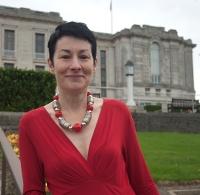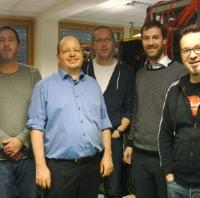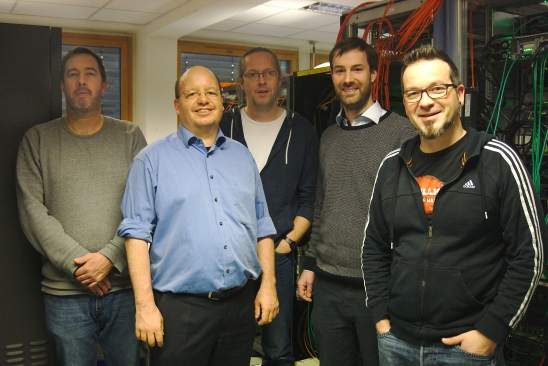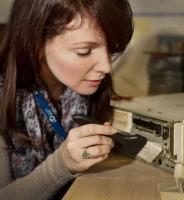Blog
Unless otherwise stated, content is shared under CC-BY-NC Licence
The Threat of the Double Extinction
Cees Hof is Project Acquisition Manager at Data Archiving and Networked Services(DANS) in the Netherlands
A first glimpse at the DPC ‘Save the Bits’ announcement on the compilation of a list of Digitally Endangered Species confused me when it passed my screen. Further scanning the text only increased this feeling as I encountered more ‘species’ related references, but it soon turned out I was misled by my own biologically biased search image.
It was especially the ‘IUCN Red List of Threatened Species’ that was steering me wrong. A list very familiar to me as a former coordinator of several large Biodiversity data programmes. But the DPC suggested list had nothing to do with plants, animals and microbes soon to disappear from our planet’s surface. It was all about their digital equivalents occupying binary niches and threatened by the lack of proper digital archives, outdated software formats, or insufficient human efforts to safeguard their existence.
Two early episodes on digital preservation… plus one!
José Borbinha works at INESC-ID – Instituto Superior Técnico (IST) at Lisbon University, Portugal
(Episode 1) When unsuccessful digital preservation can be convenient
The year of 1998 was special. In May, it opened the Lisbon World Exposition! In June, it was held the “Sixth DELOS Workshop on Preservation of Digital Information” in the beautiful Tomar. Finally, in October, I became CIO of the National Library of Portugal.
In retrospective, 1998 was my definitive commitment with this great world of digital libraries and archives. A seed has been planted in 1996, when I got involved in the new DELOS Working Group on Digital Libraries, and it blossom in 2000 when I had the privilege of organizing the 4th ECDL conference in Lisbon. DELOS was a community that still brings special memories (“saudade” as we say in Portuguese - https://en.wikipedia.org/wiki/Saudade)
Lansio Polisi Cadwedigaeth Ddigidol i Gymru / Launching the Digital Preservation Policy for Wales
Sally McInnes is Director of Unique Collections at the National Library of Wales
Today is the first International Digital Preservation Day. The aim of the day is to create greater awareness of digital preservation and the issues associated with preserving and providing access to digital material. There are particular challenges associated with the preservation of digital material, notably the fast pace of software and hardware developments, the increasing complexity of digital resources and the resulting impact on the stability of such media. If digital material is to remain accessible, both in the short-term for business continuity, research, economic and legal requirements and for preserving the historic record in the longer-term, measures have to be taken to ensure that this information is accessible.
The International Digital Preservation Day has been co-ordinated by the Digital Preservation Coalition http://www.dpconline.org/. The NLW is a long-term member of the DPC, the aim of which is to support its members to make digital information available in the future. It has published a 'Bit List' of the World's Endangered Digital Species http://dpconline.org/our-work/bit-list) which has been unveiled today as part of this campaign to raise awareness of the need to preserve digital materials.
Guten Tag from the North Rhine-Westphalian Library Service Centre
Martin Iordanidis is Information Safety Officer at HBZ in Germany
Hey, thats us! Us at the North Rhine-Westphalian Library Service Centre (hbz) in Cologne, which is an authority of the federal state of North Rhine-Westphalia, Germany.
The Costs of Inaction: advocating for digital preservation
Neil Beagrie is Director of Consultancy at Charles Beagrie Ltd
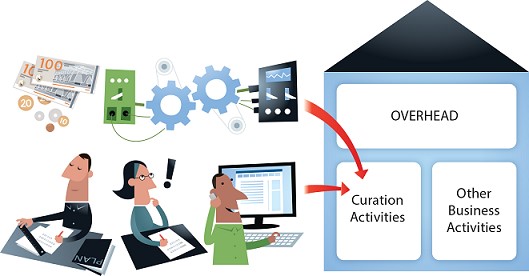
Illustration by Jørgen Stamp digitalbevaring.dk CC BY 2.5 Denmark
Traditionally the major challenge in digital preservation has been seen to be technology obsolesence. However, arguably the organisational challenges, particularly funding (and advocacy for funding), have proved to be much more significant over time.
In recent years an increasing number of community efforts have focussed on helping organisations to identify benefits and write a business case for digital preservation. The Keeping Research Data Safe (KRDS) Digital Preservation Benefits Analysis Tools and the Digital Preservation Business Case Toolkit are good examples.
Digital Preservation Milestones at the University of Sheffield
Chris Loftus is Digital Preservation Manager at the University of Sheffield Western Bank Library in the UK
The first International Digital Preservation day allows us an opportunity to reflect on some of the milestones and significant events so far in the implementation of the University of Sheffield’s Digital Preservation programme. The Library became one of the early adopters of Rosetta, a Digital Preservation solution provided by ExLibris, in 2015. Following installation Rosetta was given the Sheffield brand name ArchiveUS and initial priority focussed on developing ingest routes for our valuable digital material; born digital and digitised collections from Special Collections and the National Fairground and Circus Archive.
In September 2016 the University's Festival of the Mind event gave the Library the opportunity to highlight the thinking behind Digital Preservation through a collaboration with local artist Paul Carruthers. ‘Memories in the digital age’ is a triptych film that featured difficult to access footage from the library’s collections. The piece, which was exhibited at Sheffield’s Millennium Gallery, explored some of the ideas underpinning Digital Preservation; such as the generation and use of digital information and its relationship to memory.
To deposit, or not to deposit (or whether it is a question at all)
Kuldar Aas is Deputy Director of Digital Archives at the National Archives of Estonia
Prologue
October 2006. A workshop discussing digital information management. A known and respected IT visionary comes up and delivers a statement about file format obsolescence: “It is really not an issue to worry about. In ten years we will certainly have artificial intelligence which is able to render any bitstream there is”.

Pixabay, CC0, https://pixabay.com/en/artificial-intelligence-robot-ai-ki-2167835/
The digital society and the digital archivist
“Dear community! My name is Kuldar and I’m a digital archivist in Estonia.”
The particular thing to note about this confession is the country as such – just Google for it and you are guaranteed to get a fair number of hits which describe how in e-Estonia you can set up companies in 18 minutes, declare taxes in 3 minutes, or tell you that 99% of public services are available online. Digging a bit further you will find out how Estonia has implemented nice things like ‘once-only’, ‘digital by default’, and ‘no legacy’ – principles which, when spoken out aloud, will lead any reasonable archivist straight to a mental institution along with inflicting a serious heart condition.
A day at the digital archives of the National Archives of Denmark
Anders Bo Neilsen is the Senior Adviser on Digital Preservation at the Danish National Archives
Thursday was yet another busy and versatile day here at the section of Digital Preservation of the Danish National Archives. As usual there were the daily audit reports and the results of the quality assurance of the ingested SIPs which once again were spit out (pun intended) by our QA system. The producers of the SIPs were notified and given a new deadline for resubmitting SIPs which we can ingest and digest. Almost all of the rejected SIPs were produced by national authorities, but one or two were actually produced by a colleague. A taste of one's own medicine can be bitter and hard to stomach. The errors were the typical ones: lack of context documentation, missing explanation of code values, broken referential integrity and poor conversions to TIFF.
Having dealt with the ingest problems we turned our focus on the next item in the process, the packaging and storage of the AIPs. We are in the process of storing five AIPs from five similar authorities ranging in size from two to eight TB. At first we could not understand the huge size of these AIPs produced from ordinary digital case and document management systems. It seems that many incoming documents are an order of magnitude larger than the outgoing. Apparently, quite a few citizens seem to reply to these authorities by printing out the documents they receive, adding handwritten comments on them, taking pictures of all the pages using their smart phone, and emailing them to the authorities. That is how an outgoing black and white document is transformed into an incoming document in full colour - and full size.
Name that item in…?
Kirsty Lee is Digital Archivist for the Division of Library and University Collections at the University of Edinburgh, Scotland.
I’d like to start International Digital Preservation Day, by putting a conundrum out to the community. My colleague, Lorraine McLaughlin, here at the Centre for Research Collections in the University of Edinburgh, and myself are currently appraising a hybrid collection that documents the history of computing at Edinburgh University from the inception of the Edinburgh Regional Computing Centre (ERCC) in 1966, to its later incarnation the Edinburgh University Computing Service in the 1980s.
The ERCC was to have a considerable impact on computing services as we know them today. Following the Flowers Report in 1966 there was to be regional computing centres set up in London, Manchester and Edinburgh tasked with providing computing services for local university users, research council establishments and other universities.
Keynote Address at 'RecordDNA: developing a research agenda for the future digital evidence base...', Westminster
Nick Thomas-Symonds MP is co-Chair of the All-Party Group on Archives and History for UK Parliament.
This blog post is the text for a speech delivered by Nick Thomas-Symonds MP on 30 November 2017 at a RecordDNA event at Westminster.
As Co-Chair of the All Parliamentary Archives Group I am delighted to open this event, which is being held on International Digital Preservation Day. Delighted also to welcome such an impressive range of speakers. Let me start by thanking Elizabeth Lomas of UCL and Julie McLeod of Northumbria University, for organising and implementing such an impressive programme. Thanks also to all of you for coming. You are a critical part of this partnership.
Records matter. We all depend on them. Members of Parliament rely on them to inform debate, make better laws and hold the executive to account. Everyone will at some point need records, whether investigators into injustice, members of the public researching their family history or needing access to their health history, or scholars needing an evidence base for their research.















































































































































